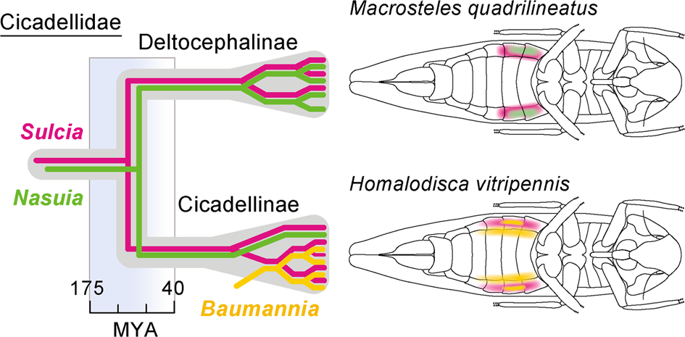Our official English website, www.x-mol.net, welcomes your
feedback! (Note: you will need to create a separate account there.)
Symbiont replacements reset the co-evolutionary relationship between insects and their heritable bacteria.
The ISME Journal ( IF 10.8 ) Pub Date : 2020-02-19 , DOI: 10.1038/s41396-020-0616-4 Meng Mao 1 , Gordon M Bennett 1
The ISME Journal ( IF 10.8 ) Pub Date : 2020-02-19 , DOI: 10.1038/s41396-020-0616-4 Meng Mao 1 , Gordon M Bennett 1
Affiliation

|
Auchenorrhynchan insects (Hemiptera) generally depend on two bacterial symbionts for nutrition. These bacteria experience extreme genome reduction and loss of essential cell functions that require direct host support, or the replacement of failing symbionts with more capable ones. However, it remains unclear how hosts adapt to integrate symbionts into their systems, particularly when they are replaced. Here, we comparatively investigated the evolution of host-support mechanisms in the glassy-winged sharpshooter, Homalodisca vitripennis (GWSS), and the aster leafhopper, Macrosteles quadrilineatus (ALF). ALF harbors the ancestral co-symbionts of the Auchenorrhyncha that have tiny genomes, Sulcia (190 kb) and Nasuia (112 kb). In GWSS, Sulcia retains an expanded genome (245 kb), but Nasuia was replaced by the more capable Baumannia (686 kb). To support their symbionts, GWSS and ALF have evolved novel mechanisms via horizontal gene transfer, gene duplication, and co-option of mitochondrial support genes. However, GWSS has fewer support systems targeting essential bacterial processes. In particular, although both hosts use ancestral mechanisms to support Sulcia, GWSS does not encode all of the same support genes required to sustain Sulcia-ALF or Nasuia. Moreover, GWSS support of Baumannia is far more limited and tailored to its expanded capabilities. Our results demonstrate how symbiont replacements shape host genomes and the co-evolutionary process.
中文翻译:

共生体置换重置了昆虫与其可遗传细菌之间的共同进化关系。
Auchenorrhynchan昆虫(半翅目昆虫)通常依靠两种细菌共生素来获得营养。这些细菌经历了极端的基因组减少和必需的细胞功能丧失,而这些功能需要直接的宿主支持,或者将失效的共生体替换为功能更强的共生体。但是,仍不清楚主机如何适应将共生体集成到其系统中,尤其是在更换它们时。在这里,我们比较地研究了玻璃状翅膀的神枪手Homalodisca vitripennis(GWSS)和翠菊叶蝉Macrosteles quadrilineatus(ALF)中宿主支持机制的演变。ALF包含Auchenorrhyncha的祖先共共生体,它们具有很小的基因组,Sulcia(190 kb)和Nasuia(112 kb)。在GWSS中,Sulcia保留了一个扩展的基因组(245 kb),但Nasuia被功能更强大的Baumannia(686 kb)所取代。为了支持它们的共生体,GWSS和ALF通过水平基因转移,基因复制和线粒体支持基因的共选进化了新的机制。但是,GWSS具有针对基本细菌过程的支持系统较少。特别是,尽管两个宿主都使用祖先机制来支持Sulcia,但GWSS并不编码维持Sulcia-ALF或Nasuia所需的所有相同支持基因。此外,GWSS对Baumannia的支持非常有限,并针对其扩展功能而量身定制。我们的结果证明了共生体置换如何塑造宿主基因组和共同进化过程。特别是,尽管两个宿主都使用祖先机制来支持Sulcia,但GWSS并不编码维持Sulcia-ALF或Nasuia所需的所有相同支持基因。此外,GWSS对Baumannia的支持非常有限,并针对其扩展功能而量身定制。我们的结果表明共生体置换如何塑造宿主基因组和共同进化过程。特别是,尽管两个宿主都使用祖先机制来支持Sulcia,但GWSS并不编码维持Sulcia-ALF或Nasuia所需的所有相同支持基因。此外,GWSS对Baumannia的支持非常有限,并针对其扩展功能而量身定制。我们的结果证明了共生体置换如何塑造宿主基因组和共同进化过程。
更新日期:2020-02-19
中文翻译:

共生体置换重置了昆虫与其可遗传细菌之间的共同进化关系。
Auchenorrhynchan昆虫(半翅目昆虫)通常依靠两种细菌共生素来获得营养。这些细菌经历了极端的基因组减少和必需的细胞功能丧失,而这些功能需要直接的宿主支持,或者将失效的共生体替换为功能更强的共生体。但是,仍不清楚主机如何适应将共生体集成到其系统中,尤其是在更换它们时。在这里,我们比较地研究了玻璃状翅膀的神枪手Homalodisca vitripennis(GWSS)和翠菊叶蝉Macrosteles quadrilineatus(ALF)中宿主支持机制的演变。ALF包含Auchenorrhyncha的祖先共共生体,它们具有很小的基因组,Sulcia(190 kb)和Nasuia(112 kb)。在GWSS中,Sulcia保留了一个扩展的基因组(245 kb),但Nasuia被功能更强大的Baumannia(686 kb)所取代。为了支持它们的共生体,GWSS和ALF通过水平基因转移,基因复制和线粒体支持基因的共选进化了新的机制。但是,GWSS具有针对基本细菌过程的支持系统较少。特别是,尽管两个宿主都使用祖先机制来支持Sulcia,但GWSS并不编码维持Sulcia-ALF或Nasuia所需的所有相同支持基因。此外,GWSS对Baumannia的支持非常有限,并针对其扩展功能而量身定制。我们的结果证明了共生体置换如何塑造宿主基因组和共同进化过程。特别是,尽管两个宿主都使用祖先机制来支持Sulcia,但GWSS并不编码维持Sulcia-ALF或Nasuia所需的所有相同支持基因。此外,GWSS对Baumannia的支持非常有限,并针对其扩展功能而量身定制。我们的结果表明共生体置换如何塑造宿主基因组和共同进化过程。特别是,尽管两个宿主都使用祖先机制来支持Sulcia,但GWSS并不编码维持Sulcia-ALF或Nasuia所需的所有相同支持基因。此外,GWSS对Baumannia的支持非常有限,并针对其扩展功能而量身定制。我们的结果证明了共生体置换如何塑造宿主基因组和共同进化过程。











































 京公网安备 11010802027423号
京公网安备 11010802027423号